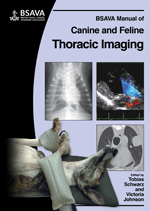
Full text loading...

Please note. The new 2nd edition of the BSAVA Manual of Canine and Feline Thoracic Imaging is now available here.
The boundaries of the canine and feline thoracic cavity consist of the thoracic skeleton, the cranial and caudal thoracic apertures and the covering soft tissue structures. The rib cage is covered by thoracic, pectoral, spinal and other musculature, subcutaneous fat and skin, and serves as an attachment for the thoracic extremities. The chapter considers Radiographic anatomy; Interpretive principles; Diseases of the thoracic skeleton; Diseases of the thoracic inlet; Diseases of the diaphragm.
The thoracic boundaries, Page 1 of 1
< Previous page | Next page > /docserver/preview/fulltext/10.22233/9781910443088/9781910443088.14-1.gif

Full text loading...
























































